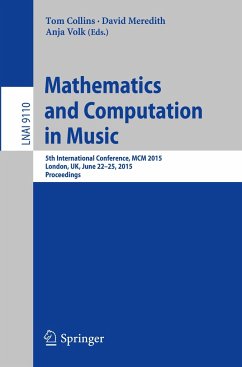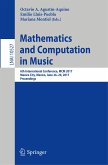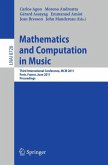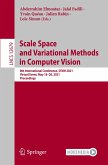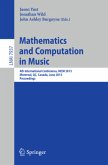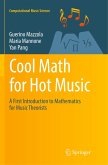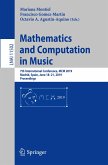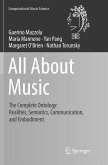Mathematics and Computation in Music
5th International Conference, MCM 2015, London, UK, June 22-25, 2015, Proceedings
Herausgegeben:Collins, Tom; Meredith, David; Volk, Anja
Mathematics and Computation in Music
5th International Conference, MCM 2015, London, UK, June 22-25, 2015, Proceedings
Herausgegeben:Collins, Tom; Meredith, David; Volk, Anja
- Broschiertes Buch
- Merkliste
- Auf die Merkliste
- Bewerten Bewerten
- Teilen
- Produkt teilen
- Produkterinnerung
- Produkterinnerung
This book constitutes the thoroughly refereed proceedings of the 5th International Conference on Mathematics and Computation in Music, MCM 2015, held in London, UK, in June 2015. The 24 full papers and 14 short papers presented were carefully reviewed and selected from 64 submissions. The papers feature research that combines mathematics or computation with music theory, music analysis, composition, and performance. They are organized in topical sections on notation and representation, music generation, patterns, performance, similarity and contrast, post-tonal music analysis, geometric approaches, deep learning, and scales.…mehr
Andere Kunden interessierten sich auch für
![Mathematics and Computation in Music Mathematics and Computation in Music]() Mathematics and Computation in Music49,99 €
Mathematics and Computation in Music49,99 €![Mathematics and Computation in Music Mathematics and Computation in Music]() Mathematics and Computation in Music39,99 €
Mathematics and Computation in Music39,99 €![Scale Space and Variational Methods in Computer Vision Scale Space and Variational Methods in Computer Vision]() Scale Space and Variational Methods in Computer Vision38,99 €
Scale Space and Variational Methods in Computer Vision38,99 €![Mathematics and Computation in Music Mathematics and Computation in Music]() Mathematics and Computation in Music35,99 €
Mathematics and Computation in Music35,99 €![Cool Math for Hot Music Cool Math for Hot Music]() Guerino MazzolaCool Math for Hot Music49,99 €
Guerino MazzolaCool Math for Hot Music49,99 €![Mathematics and Computation in Music Mathematics and Computation in Music]() Mathematics and Computation in Music62,99 €
Mathematics and Computation in Music62,99 €![All About Music All About Music]() Guerino MazzolaAll About Music38,99 €
Guerino MazzolaAll About Music38,99 €-
-
-
This book constitutes the thoroughly refereed proceedings of the 5th International Conference on Mathematics and Computation in Music, MCM 2015, held in London, UK, in June 2015. The 24 full papers and 14 short papers presented were carefully reviewed and selected from 64 submissions. The papers feature research that combines mathematics or computation with music theory, music analysis, composition, and performance. They are organized in topical sections on notation and representation, music generation, patterns, performance, similarity and contrast, post-tonal music analysis, geometric approaches, deep learning, and scales.
Produktdetails
- Produktdetails
- Lecture Notes in Computer Science 9110
- Verlag: Springer / Springer International Publishing / Springer, Berlin
- Artikelnr. des Verlages: 978-3-319-20602-8
- 2015
- Seitenzahl: 408
- Erscheinungstermin: 26. Juni 2015
- Englisch
- Abmessung: 235mm x 155mm x 23mm
- Gewicht: 644g
- ISBN-13: 9783319206028
- ISBN-10: 3319206028
- Artikelnr.: 42813643
- Herstellerkennzeichnung
- Springer-Verlag GmbH
- Tiergartenstr. 17
- 69121 Heidelberg
- ProductSafety@springernature.com
- Lecture Notes in Computer Science 9110
- Verlag: Springer / Springer International Publishing / Springer, Berlin
- Artikelnr. des Verlages: 978-3-319-20602-8
- 2015
- Seitenzahl: 408
- Erscheinungstermin: 26. Juni 2015
- Englisch
- Abmessung: 235mm x 155mm x 23mm
- Gewicht: 644g
- ISBN-13: 9783319206028
- ISBN-10: 3319206028
- Artikelnr.: 42813643
- Herstellerkennzeichnung
- Springer-Verlag GmbH
- Tiergartenstr. 17
- 69121 Heidelberg
- ProductSafety@springernature.com
A Structural Theory of Rhythm Notation Based on Tree Representations and Term Rewriting.- Renotation from Optical Music Recognition.- Foundations for Reliable and Flexible Interactive Multimedia Scores.- Genetic Algorithms Based on the Principles of Grundgestalt and Developing Variation.- Describing Global Musical Structures by Integer Programming on Musical Patterns.- Improved Iterative Random Walk for Four-Part Harmonization.- Location Constraints for Repetition-Based Segmentation of Melodies.- Modeling Musical Structure with Parametric Grammars.- Perfect Balance: A Novel Principle for the Construction of Musical Scales and Meters.- Characteristics of Polyphonic Music Style and Markov Model of Pitch-Class Intervals.- A Corpus-Sensitive Algorithm for Automated Tonal Analysis.- Finding Optimal Triadic Transformational Spaces with Dijkstra's Shortest Path Algorithm.- A Probabilistic Approach to Determining Bass Voice Leading in Melodic Harmonisation.- Hypergestures in Complex Time: Creative Performance Between Symbolic and Physical Reality.- Generating Fingerings for Polyphonic Piano Music with a Tabu Search Algorithm.- Logistic Modeling of Note Transitions.- Evaluating Singer Consistency and Uniqueness in Vocal Performances.- A Change-Point Approach Towards Representing Musical Dynamics.- Structural Similarity Based on Time-Span Sub-Trees.- Cross Entropy as a Measure of Musical Contrast.- Symbolic Music Similarity Using Neuronal Periodicity and Dynamic Programming.- Applications of DFT to the Theory of Twentieth-Century Harmony.- Utilizing Computer Programming to Analyze Post-Tonal Music: Contour Analysis of Four Works for Solo Flute.- A Statistical Approach to the Global Structure of John Cage's Number Piece Five .- Exact Cover Problem in Milton Babbitt's All-Partition Array.- Constructing Geometrical Spaces from Acoustical Representations.- Geometry, Iterated Quantization and Filtered Voice-Leading Spaces.- Using Fundamental Groups and Groupoids of ChordSpaces to Model Voice Leading.- All-Interval Structures.- Unifying Tone System Definitions: Ordering Chromas.- A Categorical Generalization of Klumpenhouwer Networks.- The Spinnen-Tonnetz: New Musical Dimensions in the 2D Network for Tonal Music Analysis: Using Polarization and Tonal Regions in a Dynamic Environment.- Probabilistic Segmentation of Musical Sequences Using Restricted Boltzmann Machines.- ¿El Caballo Viejo? Latin Genre Recognition with Deep Learning and Spectral Periodicity.- Can a Musical Scale Have 14 Generators?.- On the Step-Patterns of Generated Scales That are Not Well-Formed.- Triads as Modes within Scales as Modes.- Greek Ethnic Modal Names vs. Alia Musica's Nomenclature.
A Structural Theory of Rhythm Notation Based on Tree Representations and Term Rewriting.- Renotation from Optical Music Recognition.- Foundations for Reliable and Flexible Interactive Multimedia Scores.- Genetic Algorithms Based on the Principles of Grundgestalt and Developing Variation.- Describing Global Musical Structures by Integer Programming on Musical Patterns.- Improved Iterative Random Walk for Four-Part Harmonization.- Location Constraints for Repetition-Based Segmentation of Melodies.- Modeling Musical Structure with Parametric Grammars.- Perfect Balance: A Novel Principle for the Construction of Musical Scales and Meters.- Characteristics of Polyphonic Music Style and Markov Model of Pitch-Class Intervals.- A Corpus-Sensitive Algorithm for Automated Tonal Analysis.- Finding Optimal Triadic Transformational Spaces with Dijkstra's Shortest Path Algorithm.- A Probabilistic Approach to Determining Bass Voice Leading in Melodic Harmonisation.- Hypergestures in Complex Time: Creative Performance Between Symbolic and Physical Reality.- Generating Fingerings for Polyphonic Piano Music with a Tabu Search Algorithm.- Logistic Modeling of Note Transitions.- Evaluating Singer Consistency and Uniqueness in Vocal Performances.- A Change-Point Approach Towards Representing Musical Dynamics.- Structural Similarity Based on Time-Span Sub-Trees.- Cross Entropy as a Measure of Musical Contrast.- Symbolic Music Similarity Using Neuronal Periodicity and Dynamic Programming.- Applications of DFT to the Theory of Twentieth-Century Harmony.- Utilizing Computer Programming to Analyze Post-Tonal Music: Contour Analysis of Four Works for Solo Flute.- A Statistical Approach to the Global Structure of John Cage's Number Piece Five .- Exact Cover Problem in Milton Babbitt's All-Partition Array.- Constructing Geometrical Spaces from Acoustical Representations.- Geometry, Iterated Quantization and Filtered Voice-Leading Spaces.- Using Fundamental Groups and Groupoids of ChordSpaces to Model Voice Leading.- All-Interval Structures.- Unifying Tone System Definitions: Ordering Chromas.- A Categorical Generalization of Klumpenhouwer Networks.- The Spinnen-Tonnetz: New Musical Dimensions in the 2D Network for Tonal Music Analysis: Using Polarization and Tonal Regions in a Dynamic Environment.- Probabilistic Segmentation of Musical Sequences Using Restricted Boltzmann Machines.- ¿El Caballo Viejo? Latin Genre Recognition with Deep Learning and Spectral Periodicity.- Can a Musical Scale Have 14 Generators?.- On the Step-Patterns of Generated Scales That are Not Well-Formed.- Triads as Modes within Scales as Modes.- Greek Ethnic Modal Names vs. Alia Musica's Nomenclature.

